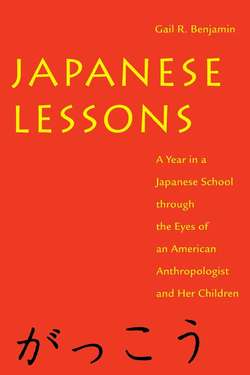Japanese Lessons

Описание книги
Gail R. Benjamin reaches beyond predictable images of authoritarian Japanese educators and automaton schoolchildren to show the advantages and disadvantages of a system remarkably different from the American one… – The New York Times Book Review Americans regard the Japanese educational system and the lives of Japanese children with a mixture of awe and indignance. We respect a system that produces higher literacy rates and superior math skills, but we reject the excesses of a system that leaves children with little free time and few outlets for creativity and self-expression. In Japanese Lessons , Gail R. Benjamin recounts her experiences as a American parent with two children in a Japanese elementary school. An anthropologist, Benjamin successfully weds the roles of observer and parent, illuminating the strengths of the Japanese system and suggesting ways in which Americans might learn from it. With an anthropologist's keen eye, Benjamin takes us through a full year in a Japanese public elementary school, bringing us into the classroom with its comforting structure, lively participation, varied teaching styles, and non-authoritarian teachers. We follow the children on class trips and Sports Days and through the rigors of summer vacation homework. We share the experiences of her young son and daughter as they react to Japanese schools, friends, and teachers. Through Benjamin we learn what it means to be a mother in Japan–how minute details, such as the way mothers prepare lunches for children, reflect cultural understandings of family and education. Table of Contents Acknowledgments 1. Getting Started 2. Why Study Japanese Education? 3. Day-to-Day Routines 4. Together at School, Together in Life 5. A Working Vacation and Special Events 6. The Three R's, Japanese Style 7. The Rest of the Day 8. Nagging, Preaching, and Discussions 9. Enlisting Mothers' Efforts 10. Education in Japanese Society 11. Themes and Suggestions 12. Sayonara Appendix. Reading and Writing in Japanese References Index
Оглавление
Gail R. Benjamin. Japanese Lessons
About NYU Press
Japanese Lessons
Contents
Acknowledgments
1 Getting Started
ENROLLING IN SCHOOL
THE SCHOOL
THE FIRST DAY AND THE EQUIPMENT
2 Why Study Japanese Education?
3 Day-to-Day Routines. DAILY SCHEDULE
A FULL-TIME OCCUPATION
CLASS TIME
REPORT CARDS, JUKU, AND EXAMINATIONS
4 Together at School, Together in Life. HAN GROUPS
GROUPS
REACTIONS
5 A Working Vacation and Special Events. SUMMER VACATION?
SPORTS DAY
THE TRIP TO AKAGI
DAY 2
6 The Three R’s, Japanese Style
READING
ARITHMETIC
SOCIAL STUDIES
7 The Rest of the Day. LESSONS AT LUNCH
PHYSICAL EDUCATION
ART AND MUSIC
MORAL EDUCATION
8 Nagging, Preaching and Discussions
9 Enlisting Mothers’ Efforts
10 Education in Japanese Society
DISADVANTAGED STUDENTS
CRITICISMS OF JAPANESE SCHOOLS
School Is Too Hard
Diploma Disease
Creativity
Conformity and School Rules
Ijime
School Refusers
11 Themes and Suggestions
12 Sayonara
Appendix Reading and Writing in Japanese
References
Index
Отрывок из книги
Thank you for buying this ebook, published by NYU Press.
Sign up for our e-newsletters to receive information about forthcoming books, special discounts, and more!
.....
At least at Okubo Higashi, children are encouraged to wear long pants during the winter months. We were told by parents that at other schools in Urawa children who wore long pants instead of skirts or the very short shorts Japanese boys usually wear were subject to ridicule by their teachers. Stoically enduring cold has long been a means of character building in Japan.
The motto found in every classroom, in the hallways, on school publications, over the stage in the auditorium, and which makes its way into many public speeches is
.....
